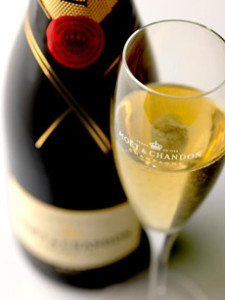TOP PICK OF THE WEEK: Yellow Tail Sparkling Rosé
|
If you’re buying sparkling wine for Christmas or New Year’s Eve, you may be tempted to buy Champagne. But unless your guests are wine connoisseurs, you can have just as pleasant an experience with other sparkling wines, for a third to half of the price of the least expensive bottle of Champagne.
Champagne is a name-protected sparkling wine that is made only in the Champagne region of northeast France. Every other wine that has bubbles is called sparkling wine. You can find sparklers from other regions and nations in the $10 to $12 range that are very satisfying in the glass. When mixed into a cocktail, no one can tell the difference. But the difference in price is substantial. The most affordable Champagnes tend to be in the $35 range. If you’re buying several bottles, do the math. We do buy Champagne and look for values—both the houses we know, like Pol Roger Brut Reserve, $35, and smaller houses that the wine clerk recommends. Champagne Nicolas Feuillatte and Jacquart are $35, the better-known Mumm is $40. A number of years ago, on a recommendation from wine expert Robert Parker, we purchased and went crazy for the $35 Egly-Ouriet, a smaller producer we’d never heard of. Today you can find bottles from $38 to $65, depending on the vintage and the retailer. |
|
|
|
WHEN YOU NEED A LOT OF BUBBLY… When multiple bottles are required, we turn our sights elsewhere, to sparkling wine varieties that are $8 to $15 a bottle. Prices will vary by retailer, but keep an eye out for:
NOTE: If you’re checking prices online, make sure they’re for standard 750ml bottles, not half bottles or splits. |
||
 Yellow Tail sparkling wine from Australia (photo at top of page) is $10. Moet et Chandon Champagne from France (photo above) is $40. Photo via Pinterest | Facebook. |
WHY IS CHAMPAGNE SO EXPENSIVE?
It’s a question of supply and demand. The supply is limited because by law, Champagne can only be produced in the Champagne region of northern France. There’s no more land that can be planted with grapes. The demand began around 1715 in Paris, when Philippe II became the Regent of France. He liked sparkling Champagne and served it nightly at dinner. The cachet was taken up by Parisan society. Winemakers in Champagne began to switch their products from still wines—the majority produced at the time—to sparkling. Throughout the 18th century, new Champagne houses were established. Moët & Chandon, Louis Roederer, Piper-Heidsieck and Taittinger were among the major houses founded during this period. Champagne has the most complex flavors among sparkling wines, and the greatest aging potential, which deepens the complexity. Its unique flavors—toasty and yeasty—are due to the layers of chalk underneath the region’s soil. |
|
|
A vast chalk plain was laid down in the Cretaceous period, 145 to 66 million years ago (it’s the same huge expanse that created the White Cliffs of Dover in England). The chalk provides good drainage and reflects the heat from the sun, two factors that influence the flavor of the grapes. Champagne makers perfected the méthode champenoise, adding a dosage of sugar that generates a secondary fermentation in the bottle. This creates the bubbles. While producers the world over use the méthode champenoise to make sparkling wines, only the vine roots in Champagne grow down into the chalk, creating the prized flavors and body. However, not everyone likes yeasty, toasty wines. Other regions produce lighter bodied wines with citrus and other fruity flavors and floral aromas. The only way to discover what you like is to taste, taste, taste.
|
||
